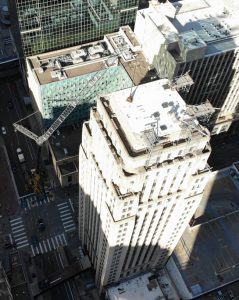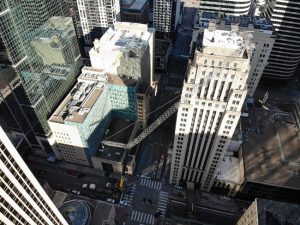
Photo courtesy Central Roofing Company
Aviator Rufus R. Rand would love the recently-renovated Rand Tower. He originally built the 26-story structure in 1929. Now, almost a century later, the historic building serves as a luxury hotel, again taking its place on the downtown Minneapolis, Minnesota, skyline. Ethylene propylene diene monomer (EPDM) roofing was used to tackle the complex renovations to the building.
Getting to this point took the effort of architects, contractors, and building specialists. Working together, they transformed the former office tower into a luxury boutique Marriott hotel. Rand Tower Hotel pays tribute to both the Art Deco style and Rand’s love of aviation.
There are eight different roofs that had to be replaced on this structure,” said Mike Mehring, vice-president of commercial sales with Minnesota-based contractor Central Roofing Company. “We worked on this project from April of 2019 through July of 2020. The different phases of work were all challenging.”
Expert roofing support
According to Brock Norman, senior project manager with Ryan Companies, nothing about the scope of the roofing on the Rand Tower project was typical or normal.
“We hired Central Roofing because they were not afraid of the challenge,” said Norman. “Mike and his team worked with our pre-construction managers to essentially formulate the scope of work. They provided a plan and details on how to accomplish updating of the roofing levels from the 26th floor down to the 6th floor.”
Simultaneously, the team at ESG Architects was also working closely with Ryan Companies to develop the roofing specifications and details for the renovation.
“A great deal of credit goes to the pre-construction team at Ryan Companies and Central Roofing for their onsite work in evaluating all existing conditions at each roof level that needed to be addressed,” said Terry Gruenhagen, AIA, LEED AP, principal at ESG Architects. “Special attention was paid to the rooftop addition and the waterproof membrane on the exterior roof terrace and interior bar area. We have a high degree of confidence that the roof system will protect the new hotel from water intrusion for many years to come.”

Complex coordination
Since swing stages (otherwise known as suspended scaffolding) were used for most of the roofing work, all activities had to be precisely coordinated. Often the work was scheduled down to the minute or hour, instead of just for a particular day.
After installing anchors on the upper roof areas, the swings could be tied off. Multiple swings were installed around the building with each contractor taking turns on the stages. This mandated the eight roofs be completed in different phases.
Tackling the project one roof at a time
The roofing project started with the removal of a 15-year-old polyvinyl chloride (PVC) roof on the highest roof of the building. Several rooftop unit curbs and fall protection anchors were then installed. At the same time, the Central Roofing team brought the roof membrane up to normal performance levels and worked on preventative maintenance for the roof.
At roof level 26, a ballasted EPDM roof covered with pavers was replaced with a 60-mil fully adhered system. The pavers were reused to help protect the roof while tradespersons walked on it to perform mechanical equipment repairs.
As Mehring remembers, the roofing on levels 25, 24, 23, 21, and three were leaking profusely. They came up with a plan to replace them with the same EPDM membrane that was used on the top level.
“We took out the existing copper sheet metal roofing that was covered with a coating. Our solution with the 60-mil membrane system should keep the roof solid and leak-free,” said Mehring.
Adding a rooftop restaurant
When it came to level five of the Rand Tower, life got even more interesting for the roofing team. The original roof on level five of the Rand Tower had an old thermoplastic polyolefin (TPO) roofing membrane covering, and an even older built-up roofing (BUR) system. Central Roofing employees removed the roof to allow for new construction.
A new rooftop dining area was constructed on level five. A retractable skylight/roof was added, plus an outdoor patio. Central Roofing installed sheet metal within the retractable roof area to mask areas on the building walls with imperfections.
Finally, the Central Roofing team installed a 215-mil fabric reinforced water proofing system for both the indoor and outdoor dining locations. The roofing crew also added tile pavers to the outdoor patio.




